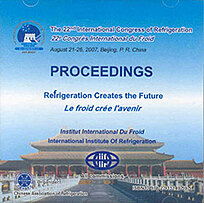
Summary
The direct evaporative internal-melt ice-storage air conditioning is an important branch of the ice-storage technology. It's working principle is: during the charging process the coils in ice-tank play as an evaporator to chill the water into ice, while during the discharging process it works as a subcooler to further reduce the refrigerant temperature at the downstream of condenser. By this process, the full-load operating efficiency of the refrigeration system can be greatly improved and the initial capacity of the air-conditioning system can be reduced as well. In this paper, the experiments were carried out to investigate the heat transfer characteristics and control principle during the icing and melting processes. The tests were based on an inverter air-conditioner system. The Nusselt number is measured along the coils for the charging process, and the correlations of Nusselt number were obtained as a function of mass quality and the ice layer thickness. The dynamic characteristics of the system about the charging and discharging processes were studied and the performance curves of the both processes were obtained. Experimental results show the power load shift rate of the experimental system achieves about 23%.
Available documents
Format PDF
Pages: ICR07-E1-724
Available
Public price
20 €
Member price*
Free
* Best rate depending on membership category (see the detailed benefits of individual and corporate memberships).
Details
- Original title: The experimental study of heat transfer and dynamic characteristics of direct evaporative internal-melt ice-storage system.
- Record ID : 2007-2673
- Languages: English
- Source: ICR 2007. Refrigeration Creates the Future. Proceedings of the 22nd IIR International Congress of Refrigeration.
- Publication date: 2007/08/21
Links
See other articles from the proceedings (839)
See the conference proceedings
Indexing
-
Average modified Stanton number for evaluating ...
- Author(s) : OHIRA A., SAKANO Y., YANADORI M., et al.
- Date : 2004
- Languages : English
- Source: ASHRAE Transactions. 2004 Winter Meeting. Volume 110, part 1 + CD-ROM.
View record
-
Numerical study on the performance of ice-based...
- Author(s) : LI Y., YANG C., WANG X., et al.
- Date : 2007/08/21
- Languages : English
- Source: ICR 2007. Refrigeration Creates the Future. Proceedings of the 22nd IIR International Congress of Refrigeration.
- Formats : PDF
View record
-
Optimization of the operating strategy for an i...
- Author(s) : ZHAO J. D., LIU N., LIU G.
- Date : 2007/08/21
- Languages : English
- Source: ICR 2007. Refrigeration Creates the Future. Proceedings of the 22nd IIR International Congress of Refrigeration.
- Formats : PDF
View record
-
Modified RC thermal circuit model applied to co...
- Author(s) : CHIANG Y. C., CHIEH J. J., CHEN H. C., et al.
- Date : 2005
- Languages : English
- Source: ASHRAE Transactions. 2005 Winter Meeting. Volume 111, part 1 + CD-ROM.
View record
-
Design and research of the commercial digital V...
- Author(s) : XIAO H. H., ZHANG T., FAN H. Y., et al.
- Date : 2006/07/17
- Languages : English
- Source: 2006 Purdue Conferences. 18th International Compressor Engineering Conference at Purdue & 11th International Refrigeration and Air-Conditioning Conference at Purdue [CD-ROM].
- Formats : PDF
View record
